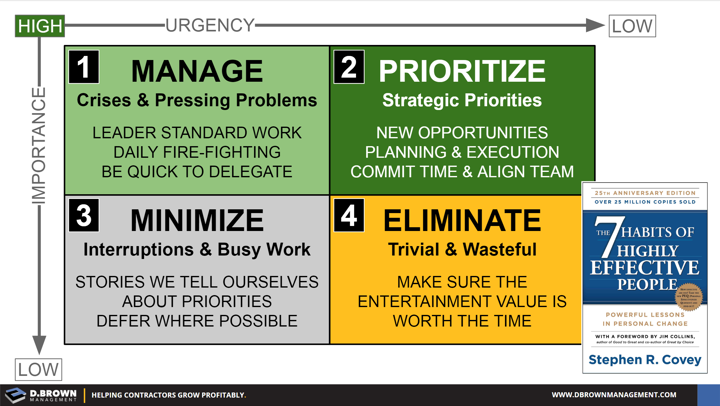In 1989, Stephen Covey published The 7 Habits of Highly Effective People where he discussed the distinction between the Urgent and the Important as part of achieving what he termed your “Personal Victory.”
In 1954, Dwight D. Eisenhower introduced a prioritization matrix that categorizes tasks based on their urgency and importance, ranking items a 2x2 grid:
- High Urgency and Hight Importance (Crises and Pressing Problems)
- Low Urgency and High Importance (Strategic Priorities)
- High Urgency and Low Importance (Interruptions & Busy Work)
- Low Urgency and Low Importance (Distractions - Trivial & Wasteful)
Being disciplined enough to focus on the truly important tasks every day is more critical today than ever. We have more distractions like app games, advertising, and social media that mostly fall into Quadrant 4 (Low Urgency and Low Importance).
As contractors navigate the stages of growth, their business models become increasingly more complex with job roles and functions. It is easy for many of these people and roles to become disconnected from both the daily ground level connection to the customer and the broader strategic choices. They can get lost in the "The Messy Middle" of the organization and start unintentionally believing that quadrant 3 and 4 activities as quadrant 1 & 2 activities.
It is the role of leadership to keep everyone aligned. This is one of the leadership focus changes that must occur with growth.
Combating this starts with understanding where your time goes. Don't guess, take an actual inventory over a 6-week period of time.
Look at everything you actually do, including the interruptions via phone, email, text, and walk-ins.
- What categories would you place these all in?
- How much of your time is spent in each quadrant?
Get other perspectives to see how different people see your time. Be open to their input but make decisions about your own time.
- Does your manager see this analysis the same way?
- Do your peers see this analysis the same way?
- Do your subordinates see this analysis the same way?
- Do your mentors and coaches see this analysis the same way?
Advanced Tip: Extend this beyond your professional day. How would you define these four quadrants for your life as a whole? This can get you a lot closer to a "Perfect Life."
Once your inventory is complete, now start making plans to improve your time allocation.
- What doesn't have to be done at all? Don't rationalize this one. You would be surprised at how little actually must be done.
- What can you say 'NO' to doing?
- What can you delegate?
- What can be improved if you build it into a standard routine (Leader Standard Work)?
- What can be improved by creating some standard processes and using tools to streamline?
Advanced Tip: How do you help the people that work for you achieve the same improvements?
Caution: Don't try to help anyone else with this until you are well along the path toward your own mastery.
"Yesterday I was clever so I wanted to change the world. Today I am wise so I am changing myself.” - Rumi
Learn More: The Effective Executive by Peter F. Drucker (Chapter 2: Know Thy Time)

